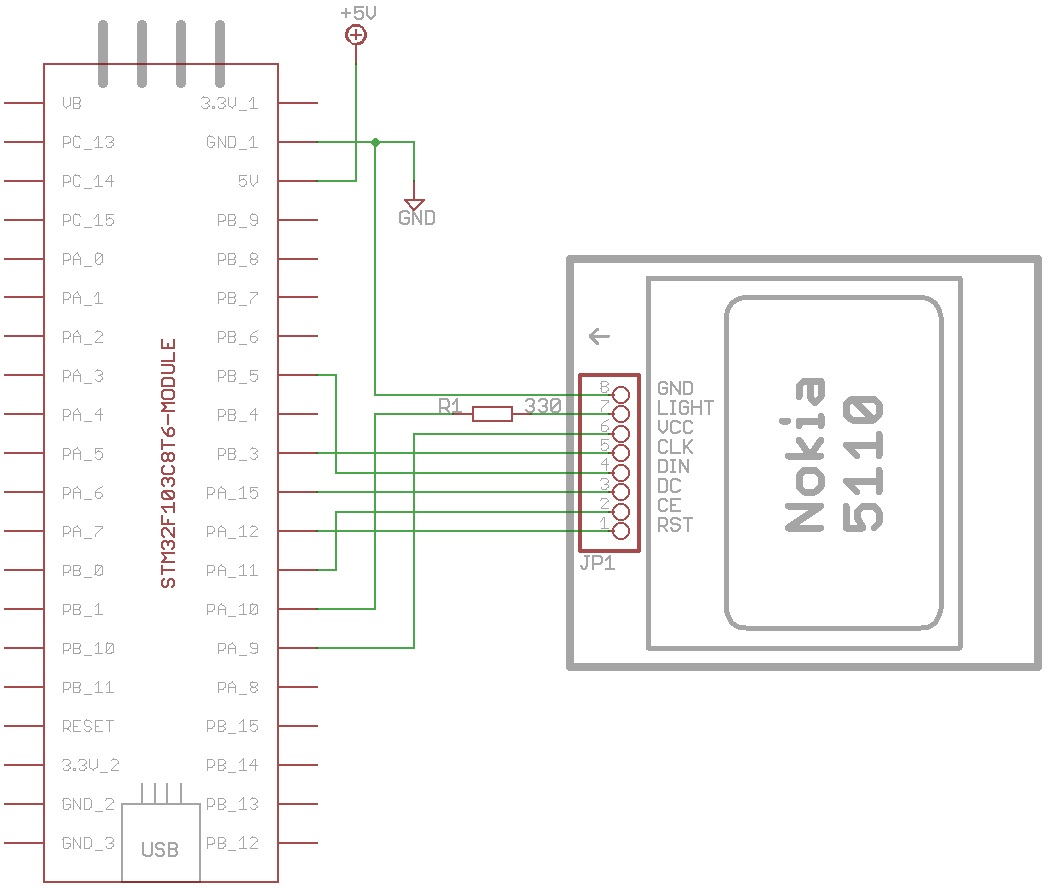Demo for STM32F103C8T6 with a Nokia 5110 LCD.
Nokia 5110 LCD driven by STM32F103C8T6 board
This is a fork of Craig Evans' example program using his N5110 library.
Schematic

Wiring
| STM32F103C8T6 | Nokia 5110 | |||
|---|---|---|---|---|
| GND | <=> | GND | ||
| PA_10 | <R1> | LIGHT | ||
| PA_9 | <=> | VCC | ||
| PB_3 | <=> | CLK | ||
| PB_5 | <=> | DIN | ||
| PA_15 | <=> | DC | ||
| PA_11 | <=> | CE | ||
| PA_12 | <=> | RST |
main.cpp
- Committer:
- hudakz
- Date:
- 2019-02-05
- Revision:
- 2:2bab15094d3d
- Parent:
- 1:a5480500307f
File content as of revision 2:2bab15094d3d:
/*
* Nokia 5110 LCD demo
*/
#include "mbed.h"
#include "N5110.h"
N5110 lcd(PA_9, PA_11, PA_12, PA_15, PB_5, PB_3, PA_10); // VCC, CE, RST, DC, DIN, CLK, LIGHT
int main()
{
lcd.init(); // first need to initialise display
while(1) {
// these are default settings so not strictly needed
lcd.normalMode(); // normal colour mode
lcd.setBrightness(0.5); // put LED backlight on 50%
// can directly print strings at specified co-ordinates
lcd.printString("Hello, World!",0,0);
char buffer[14]; // each character is 6 pixels wide, screen is 84 pixels (84/6 = 14)
// so can display a string of a maximum 14 characters in length
// or create formatted strings - ensure they aren't more than 14 characters long
int temperature = 27;
int length = sprintf(buffer,"T = %2d C",temperature); // print formatted data to buffer
// it is important the format specifier ensures the length will fit in the buffer
if (length <= 14) // if string will fit on display
lcd.printString(buffer,0,1); // display on screen
float pressure = 1012.3; // same idea with floats
length = sprintf(buffer,"P = %.2f mb",pressure);
if (length <= 14)
lcd.printString(buffer,0,2);
// can also print individual characters at specified place
lcd.printChar('X',5,3);
// draw a line across the display at y = 40 pixels (origin top-left)
for (int i = 0; i < WIDTH; i++) {
lcd.setPixel(i,40);
}
// need to refresh display after setting pixels
lcd.refresh();
// can also check status of pixels using getPixel(x,y)
wait(5.0);
lcd.clear(); // clear display
lcd.inverseMode(); // invert colours
lcd.setBrightness(1.0); // put LED backlight on full
float array[84];
for (int i = 0; i < 84; i++) {
array[i] = 0.5 + 0.5*sin(i*2*3.14/84);
}
// can also plot graphs - 84 elements only
// values must be in range 0.0 - 1.0
lcd.plotArray(array);
wait(5.0);
lcd.clear();
lcd.normalMode(); // normal colour mode back
lcd.setBrightness(0.5); // put LED backlight on 50%
// example of drawing lines
for (int x = 0; x < WIDTH ; x+=10) {
// x0,y0,x1,y1,type 0-white,1-black,2-dotted
lcd.drawLine(0,0,x,HEIGHT,2);
}
lcd.refresh(); // need to refresh screen after drawing lines
wait(5.0);
lcd.clear();
// example of how to draw circles
lcd.drawCircle(WIDTH/2,HEIGHT/2,20,FILL_BLACK); // x,y,radius,black fill
lcd.drawCircle(WIDTH/2,HEIGHT/2,10,FILL_WHITE); // x,y,radius,white fill
lcd.drawCircle(WIDTH/2,HEIGHT/2,30,FILL_TRANSPARENT); // x,y,radius,transparent with outline
lcd.refresh(); // need to refresh screen after drawing circles
wait(5.0);
lcd.clear();
// example of how to draw rectangles
// origin x,y,width,height,type
lcd.drawRect(10,10,50,30,FILL_BLACK); // filled black rectangle
lcd.drawRect(15,15,20,10,FILL_WHITE); // filled white rectange (no outline)
lcd.drawRect(2,2,70,40,FILL_TRANSPARENT); // transparent, just outline
lcd.refresh(); // need to refresh screen after drawing rects
wait(5.0);
lcd.clear();
}
}